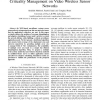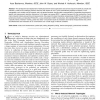842 search results - page 88 / 169 » Distributed Innovation in Classes of Networks |
CORR
2007
Springer
13 years 9 months ago
2007
Springer
— The differential encoding/decoding setup introduced by Kiran et al, Oggier et al and Jing et al for wireless relay networks that use codebooks consisting of unitary matrices is...
ICUMT
2009
13 years 6 months ago
2009
In WSN-based surveillance systems power conservation is an important issue but one must also ensure that the application's objectives are met. In this paper, we jointly addres...
INFOCOM
2002
IEEE
14 years 2 months ago
2002
IEEE
—The development and deployment of distributed network-aware applications and services require the ability to compile and maintain a model of the underlying network resources wit...
CAMAD
2006
IEEE
14 years 24 days ago
2006
IEEE
Abstract-- This paper evaluates the performance of a distributed and lightweight AC model based on per-class edge-toedge monitoring feedback for ensuring the quality of multiple se...
SIROCCO
2008
13 years 10 months ago
2008
Consider a synchronized distributed system where each node can only observe the state of its neighbors. Such a system is called selfstabilizing if it reaches a stable global state ...


